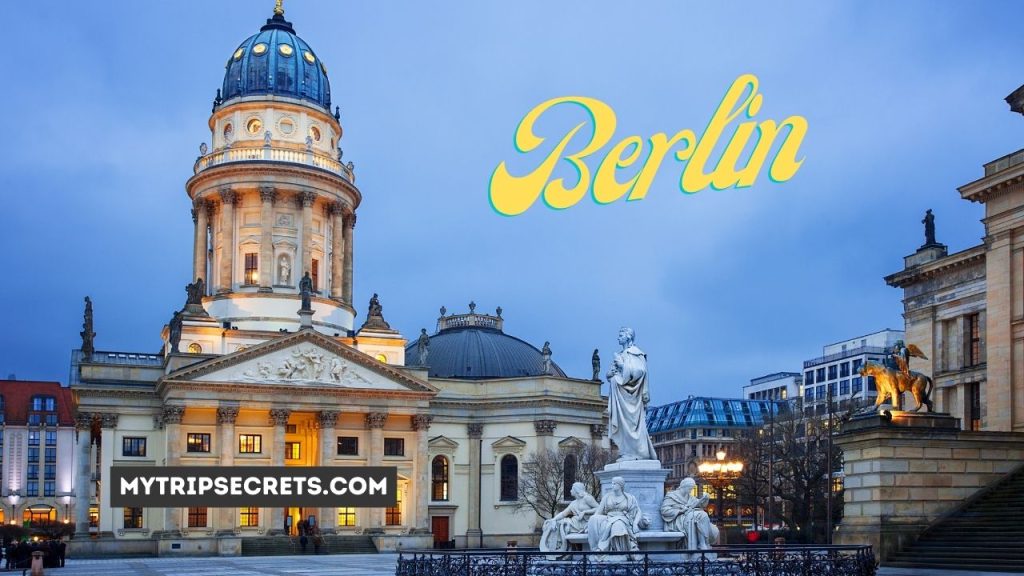Germany is a country filled with a tumultuous yet fascinating history. From great empires and kingdoms to the rise of the Nazis and Cold War era separation, few places symbolize Germany’s storied past more than Berlin and Dresden. While vibrant Berlin stands today as a thriving capital and art hub, the elegant city of Dresden shows both the glorious and tragic sides of history. Taking a day trip on the short 120 km route between Berlin and Dresden allows you to dive into the key events that have shaped Germany as you explore world-class museums, imposing castles, gardens, and monuments.
Contents
- 1 Berlin to Dresden Day Trip
- 2 Sightseeing Itinerary and Timing
- 3 Top Things to See and Do
- 4 20 Travel Tips for Berlin to Dresden Day Trip
- 5 Frequently Asked Questions
- 5.1 How early should I arrive for my return train to Berlin?
- 5.2 What is there to see between Berlin & Dresden along the route?
- 5.3 Where can I store luggage in Dresden on a day trip?
- 5.4 How should I pay for transportation and sights on this trip?
- 5.5 What language is mainly spoken in Dresden?
- 5.6 How much walking is needed to see Dresden’s top sights?
- 6 Conclusion
Berlin to Dresden Day Trip
Thanks to smooth, modern infrastructure getting between Berlin and Dresden for a day trip is simple. The journey takes just over 2 hours each way by train or car. Here are the best transportation options:
By Train
The easiest and most popular public transportation option is taking the Deutsche Bahn high-speed train between Berlin and Dresden. Trains depart every 30-60 minutes from early morning to late evening for the entire route. Relax in roomy seats for the 2 hour and 10 minute direct ride through scenic German countryside. Roundtrip fares start around $60-70. Grab snacks and use the free onboard WiFi.
By Rental Car
Renting a car offers maximum sightseeing flexibility in Dresden at your own pace. The drive via the speedy A13 Autobahn takes just under 2 hours from Berlin. Stop along the way in towns like Radebeul. Major rental agencies like SIXT, Europcar, Hertz, Avis and Budget have Berlin pick-up locations. Reserve a car with GPS navigation included to ease driving. Expect rental rates around $50-70 per day. Fuel costs and tolls are extra expenses to consider for this freedom and convenience.
By Bus
While slower, Flixbus and other intercity budget buses like DeinBus run daily direct routes between Berlin and Dresden as the most affordable option. The total trip lasts 3.5 hours with a change in Riesa. Purchase e-tickets in advance online for one-way fares around $15-25 per person. Onboard amenities vary from electrical outlets to WiFi depending on carrier and bus type.
| Transport | Duration | Price (Roundtrip) |
|---|---|---|
| Train | 4 hrs 20 min | $60-70 |
| Rental Car | 4 hrs | $100-140 + gas & tolls |
| Bus | 7 hrs | $30-50 |
Sightseeing Itinerary and Timing
No matter how you travel, having an efficient strategy is key to experience Dresden’s cultural treasures in a quick day trip. Here is a recommended 10-12 hour timeline optimized to maximize your day before returning to Berlin:
Morning: 8 AM – 1 PM
- 8 AM: Depart Berlin
- 10 AM: Arrive Dresden main train station
- 10:30-11:45 AM: Old Masters Gallery Paintings- 1.25 hour
- 12 PM: Quick lunch inside Frauenkirche Church
- 12:30-2 PM: Frauenkirche Church + Neumarkt Square – 1.5 hours
Afternoon: 2 PM – 8 PM
- 2-3:30 PM: Royal Palace Tour – 1.5 hours
- 3:45-5:15 PM: Zwinger Museum Complex – 1.5 hours
- 5:30-7 PM: Dinner
- 7-8 PM: Head back to Berlin
This efficient schedule allows you to see Dresden’s most beautiful buildings, monuments, paintings and statues in a quick day visit. You can tweak start times, pace and order depending on preferences of course. Getting to attractions earlier is wise to avoid long entry lines.
Top Things to See and Do
With ornate Baroque palaces, charming streets in pastel hues, world-renowned art collections and tragic WWII history, Dresden offers the perfect bite-sized immersion into many quintessential aspects of German culture and history.
Marvel at Frauenkirche Church
No Dresden experience is complete without visiting the magnificent Frauenkirche church. Crowned by a bulbous stone cupola, this 18th century Lutheran Baroque church was once hailed as the “Stone Bell” and the city’s beloved symbol. Sadly the building was destroyed by Allied bombings during WWII. After the fall of Communism, Frauenkirche was painstakingly rebuilt over 10 years completed by 2005 using donated funding from around the world.
While the soaring interior dome and organ are clearly the highlights, strolling the outside courtyards and viewing the Neumarkt district rebuild efforts are moving as well. You can easily spend 1-2 hours admiring this shining church centered around peace and reconciliation once again dominating Dresden’s skyline as a testament to rebirth.
Be Enchanted at Zwinger Palace and Museums
No trip to Dresden is complete without visiting the sprawling museum complex known as Zwinger Palace. The intricate Baroque buildings topped by golden crowns were once orangeries and festival grounds for the Royal Palace next door. Today the Zwinger houses some of Germany’s finest art collections inside several galleries surrounding pristine courtyards in wings called the Glockenspiel Pavilion and Wall Pavilion.
Top highlights of Zwinger’s museums include:
- Old Masters Gallery: Admire works by masters like Raphael, Rembrandt, Rubens and Vermeer inside ornate halls.
- Porcelain Collection: Marvel at Meissen’s fine porcelain from Asian-inspired tea sets to animal figurines in the Counting House.
- Royal Cabinet of Mathematical & Physical Instruments: Wander rooms filled with globes, clocks, telescopes and magic lanterns.
- The Armory: Feast eyes upon weapons, shields and armor dating back through Saxon history.
With gilded gates, towering stone columns, graceful archways and regal courtyards around every corner, simply soaking in the ambiance is magical even without the artwork. You need 1.5-2 hours to relax and properly tour Zwinger’s treasures. Don’t forget your camera!
Immerse Yourself in Imperial History
Get a taste of Saxon nobility by touring the sprawling Dresden Royal Palace complex just steps from the Zwinger. Once home to famous Augustus the Strong and Augustus III, today you can only visit the wing housing the Historic Green Vault with ornate rooms holding dazzling jewelry and artwork collected by Saxon royals over centuries. Be dazzled by items like Indian peacock jewels, emerald bowls, ivory frigates and golden coffee sets during your 90 minute entry time slot.
For even more regal history, cross the palace bridge to tour the Taschenbergpalais wing (separate ticket). Walk royal halls to uncover stories of Augustus’s daughter and mistress who once lived here as you view opulent staterooms and ladies chambers frozen in time from the 18th century. Expect to spend another hour discovering this little visited Royal Palace wing.
Pay Respects to the Fallen
No trip to Dresden is complete without acknowledging the horrible 25,000 civilian lives lost and city destroyed during the 1945 Allied fire bombings in WWII’s final months. The haunting ruins would remain untouched for decades in the DDR times serving as anti-war monument.
Today, you can pay respects by visiting the solemn white Salzbergmann monument and pedestrian bridge overlooking the now rebuilt city skyline as well as the cross made of charred logs from the rubble at the Frauenkirche. The military museum inside the Albertstadt arsenal also has a sober audio visual display recounting events. Understanding this dark history lets you appreciate Dresden’s comeback even more.
20 Travel Tips for Berlin to Dresden Day Trip

-
Purchase roundtrip train tickets in advance online for the best fares and seat options.
-
Pack light with just a small backpack for maximum sightseeing mobility.
-
Download the DB Navigator app and Dresden transit maps on your phone.
-
Bring proper headphones to listen to free audio tours at top museums.
-
Wear sturdy walking shoes for long days trekking historic streets and museums.
-
Confirm museum opening days/hours ahead to optimize your sightseeing schedule.
-
Grab a map at the train station to orient yourself upon arrival.
-
Stay hydrated and pack snacks to recharge while sightseeing.
-
Take advantage of gorgeous photo backdrops around Dresden like bridges.
-
Budget extra time buffering between sights to account for lines and transportation.
-
Purchase multi-attraction passes to save money if visiting several museums.
-
Seek out special exhibitions happening during your visit for unique cultural immersion.
-
Allot at least 90 minutes to leisurely tour inside Frauenkirche and the grounds.
-
End your visit at the Frauenkirche dome balcony for unforgettable sunset views over Neumarkt Square.
-
Sample Dresden’s famous delicacy of saffron almond cake between museums!
-
Check the forecast and pack umbrella or light jacket even if sunny.
-
Respect no photography rules inside bestimmte museum galleries to protect artworks.
-
Take breaks to rest your feet by relaxing in parks or riverfront cafes.
-
Stay until dusk to see Dresden’s glittering cityscape glow under lights.
-
Save souvenir shopping for the main train station which stays open late.
Frequently Asked Questions
How early should I arrive for my return train to Berlin?
Arrive at Dresden’s main train station at least 30 minutes before your scheduled train departure time to account for walking to the track, longer lines, and boarding enough seats together if traveling in a group. Missing your return train means paying for new tickets.
What is there to see between Berlin & Dresden along the route?
Popular stops between Berlin and Dresden include Potsdam’s parks and palaces, the quaint town of Rheinsberg, cycling in Thyrow and the imposing Königstein Fortress built into a tabletop mountain next to the Elbe River. The region called Saxon Switzerland also has stunning nature like the Bastei bridge formations.
Where can I store luggage in Dresden on a day trip?
Dresden’s main train station has safety deposit boxes and a staffed luggage storage office called Schliessfach where you can securely store bags for around 5 Euros per piece per day. This allows you flexibility while sightseeing without suitcases.
How should I pay for transportation and sights on this trip?
Carry a mix of small cash euros for single train, bus and museum tickets as well as credit/debit cards for bigger expenses like rental cars and nice dinners. Notify your bank you are traveling internationally to prevent cards being frozen. Most museums and sights accept cards nowadays but some street food vendors or markets may still be cash only.
What language is mainly spoken in Dresden?
As Dresden is located in eastern Germany, most locals speak German first and foremost. However, many people tied to the tourism industry also speak moderate English. Learn a few key German phrases, have your hotel address handy or download an offline translation apps just in case.
How much walking is needed to see Dresden’s top sights?
Dresden’s Old Town is very compact making it quite walkable. However expect 4-6 miles of walking while crisscrossing major sights like the Zwinger, Frauenkirche and Royal Palace in a full day. Be sure to wear supportive walking shoes for cobblestone streets. Taking occasional city tram rides between distant neighborhoods can help conserve energy.
Conclusion
A day trip from Berlin to Dresden efficiently packs thousands of years of history, culture and art into 12 hours. Through lavish palaces, tragic ruins and soaring churches, the spirit of Saxony’s complicated past permeates Dresden’s streets awaiting discovery.
Use the convenient modern transportation network to effortless day trip back in time uncovering both unimaginable artistic beauty contrasted by wartime devastation now rebuilt stronger than ever. There is no better way to absorb Germany’s dichotomy than strolling Dresden’s historic streets tying together the puzzle pieces of its tearful yet resolute story.
Let moments of sorrow, joy and reconciliation wash over you around each corner to return home with profound inspiration. Dresden’s phoenix-like rebirth from ashes reminds that no matter how dark the past, hope always rises to illuminate the future.

